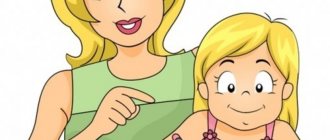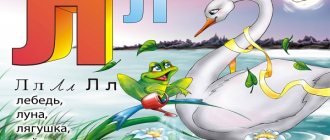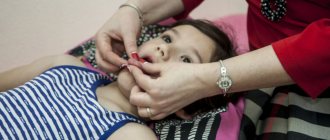One can understand the excitement of parents who suddenly discover that their preschool child speaks some sounds of their native language poorly or not at all. In this case, they are faced with the problem of how to teach the child correct sound pronunciation? Is this acceptable at home? Experts say that parents can do a lot to help a preschooler master correct sound pronunciation. You just need to have certain knowledge: about the causes of poor pronunciation, ways to correct it, ways to teach correct diction.
Causes of poor sound pronunciation
According to speech therapy standards, correct pronunciation should be formed by middle preschool age. However, even older preschoolers experience diction disorders. Experts provide evidence that children find it most difficult to pronounce hissing sounds: sh, zh, ch, shch. Imperfect diction can manifest itself in incorrect pronunciation of a sound, replacing one with another (machine-masyn), or skipping it. Experts identify the main reasons for poor pronunciation. These include the structure of the speech apparatus, insufficient development of phonemic hearing, perception, and the attitude of parents.
Features of physiology
- inactivity of the articulatory apparatus;
- improperly formed bite,
- short frenulum of the tongue,
- high palate.
Immaturity of phonemic perception
- The preschooler does not distinguish individual sounds by ear and replaces them.
Adult misbehavior
- Give the baby a pacifier for too long, especially during the period when speech is developing (early age);
- prolonged use of a pacifier leads to the formation of a malocclusion, which affects the pronunciation of many sounds, especially hissing sounds;
- deliberate distortion of speech by adults in order, in their opinion, to become understandable to the baby;
- dissatisfaction with the preschooler’s diction and the requirement to speak clearly, without teaching correct articulation;
- possible hearing loss not noticed by parents.
How can you test a preschooler’s speech at home?
Having determined that a preschooler cannot speak hissing words, parents should contact a specialist. At home, they can also examine the child’s speech to understand which sibilants are distorted. According to speech therapy rules, the examination begins with a separate pronunciation of a certain sound, then it is pronounced in syllables, words, and only then in sentences. For example:
- The parent, asking the child to reproduce the hissing words sh, zh, ch, shch, pronounces them slowly and clearly. It is more interesting to offer a game form in the form of speech exercises: “The snake hissed: sh-sh-sh”, “The bee buzzed: w-w-w.”
- To check the state of sound in syllables, the baby is encouraged to repeat syllables, for example, shi-zhi, cha-sha, zhu-shu, chu-shu, ash-azh, ach-ashch, cabbage soup, chuh, shoo, whack. In this case, the sounds being tested must be at the beginning, middle, and end of the syllable.
- The next step is to check the pronunciation of sounds in words. For interest, pictures are used where objects are drawn for a given sound (cone, giraffe, hut, teapot, pike and others). In this case, you can use speech therapy visual material, or you can choose pictures in children’s books with your child. The main thing is that they comply with certain rules: hissing words must sound clearly in words, stand at the beginning of the word, the middle, the end (fur coat, car, reed). Using the same principle, words with other hissing words are selected: beetle, gun, skis, etc. It would be good if the examination took place in the form of game exercises. For example, “How to call it affectionately (bird-bird, goat-goat, beetle-bug, winter-winter, sun-sun)? »
- The last stage involves checking the sound in a sentence in which several words with the sibilant being tested are selected. Pure sayings serve this purpose well, for example, “Hush, mice, don’t make noise! Don’t wake up the cat!” Classic tongue twisters are suitable for examining hissing ones: “Sasha was walking...”, “Cuckoo cuckoo...”
Important! When examining a child, you need to try to determine the cause of incorrect pronunciation in order to understand what influenced the distortion of diction.
Sample tasks on the topic of sibilant consonants
A teacher who will conduct a lesson for first-graders on this topic should set himself the following tasks:
- he is obliged to create conditions for children to learn the concept of hardness and softness of consonants, for example, that “zh” and “w” are always hard;
- teach students to correctly formulate writing skills;
- develop their written and coherent oral speech;
- use new information technologies when teaching.
After the teacher explains the essence of the lesson, he can write several letters on the board (B, L, CH, K, R).
Then the question is asked which of the letters presented does not denote any sound, and the correct answer is b. You can also ask students to find the letter for the hissing sound.
Next, we suggest working with a textbook of the following nature:
- children are asked to take turns reading the text (the skill of reading aloud is improved);
- we select some words and invite the children to explain their meaning (at the teacher’s choice);
- offer to find those words that contain letters denoting hissing consonants;
- Have them say them out loud and write the letters on the board.
The next part of the lesson is to work with images . Hang pictures on the board and ask students questions:
- what objects are shown in the pictures;
- what names contain hissing sounds;
- Which of the listed sizzlers are hard and which are soft.
The order of setting hissing
If a child suffers from poor pronunciation of only a specific hissing sound (sh, ch, zh, sch), it is clear that work needs to be done on producing one sound. But, as a rule, preschoolers experience distortion in the pronunciation of several sibilants at the same time. Then it is important for parents to know which sound to start with first. Experts determine the appropriate order and warn that each sound must be played individually, starting with the most accessible, gradually moving on to more complex ones. According to speech therapists, the order of production of several sounds depends on the physiology of preschool children: first the hissing sh is placed, then zh, then ch and shch. However, there may be changes in the sequence of placement, since everything depends on individual characteristics, which only a specialist can determine.
Riddles-additions for the hissing sounds Ш - Ж - Х - Ш
Practicing hissing sounds using riddles.
Goal: automation and differentiation of hissing sounds. Objectives: 1. To develop in preschoolers correct sound pronunciation, the ability to differentiate hissing sounds in their speech, and to use them correctly. 2. Use riddles to diversify the work on consolidating correct sound pronunciation and to interest children. Description: Dear colleagues, let me present you this time with riddles that add hissing sounds from your piggy bank. This speech material contributes to the formation of correct sound pronunciation in a child’s speech, develops memory, attention, and thinking. This work will be useful to speech therapists, speech therapists, educators, and parents. Contents Children love to solve riddles and I use this in my classes. I use these riddles at the stages of automation and differentiation of hissing sounds. If the child finds it difficult to guess, then you can show him a picture of the answer. It is necessary to ensure that the child clearly pronounces the sound being practiced. Additionally, you can ask the child to determine the place of the hissing sound in a word and divide the word into syllables. You can also invite your child to learn riddles and tell them to his friends. The sound “SH” The head is chilly in winter. It will come in handy in cold weather... (hat)
I pour kvass into the decanter.
I’ll pour milk into ... (jug)
I’ll put things in the closet: There are shirts, next to them - ...
(scarf)
The cat is lapping up the milk, She doesn’t even need ...
(spoon)
Among all the animals, the little one is this little gray one ...
(mouse)
Olya has a school uniform.
It's time for her to study at... (school)
Where are our kids?
They were closed... (reeds)
We are building our house together.
It will save you from the rain... (hut)
I've been learning to shoot all day.
Hanging on the closet... (target)
The cockerel loves millet.
I'll give him millet... (bag)
In the kids' yard Multi-colored...
(balloons)
Brand new tires My...
(car)
In the hot summer at the edge of the forest Two...
(cuckoos)
were cuckooing It's good for the old lady to lie on the feather bed and...
(pillow)
He lay in the sun and said : “I need...”
(shower)
It’s become a bit crowded in the hole: They’ve grown up already...
(the little mice)
I didn’t eat the chocolate, I’ll treat it later...
(the horse)
She has four ears, And her name is...
(pillow)
Our bear is offended, He doesn’t care forehead hit...
(bump)
Sound “F” “You need to sleep!
- said mom. - Here you go, yours... " (pajamas)
Very hard cakes, Give me sharp...
(knives)
Show me, my friend, Where they live in the forest...
(hedgehogs)
Yellow maple.
Winter is getting closer. Buy skates and... (skis)
He has even outgrown the closet, Because he...
(giraffe)
There are snakes on the rocks, But who is on the ice floes?
... (walruses)
Every day in the morning I eat tender blackberry ...
(jam)
There are puddles everywhere.
No paths. It pours every day... (rain)
The bear has a child.
Clumsy... (little bear)
You can learn everything from books: The red mushroom is called...
(red bear)
Grandma knits a jacket.
What is your granddaughter knitting? (vest)
It rained and grew instantly. Edible mushroom - ...
(raincoat)
The gardener planted the bushes: Blackberries and ...
(gooseberries)
Zhenya is my best friend.
In his hands... (flag)
A horse gallops past the fir trees and pines and...
(foal)
On an oak tree, among the branches, You can see a lot of...
(acorns)
Dad once told me: - Maybe someone can live in a puddle... Who?
(toad)
Sound “Ch” Be patient a little, don’t cry.
It will quickly cure a tooth... (doctor)
A fisherman suddenly caught a river goby...
(hook)
Today it is sunny and hot, And screams over the sea...
(seagull)
I'll put buckwheat in a pot and put it in...
(stove)
Medicinal chamomile tea Pour into large...
(cups)
- What should we feed the chicken?
- We will give her... (bun)
He has traveled to many countries.
Very durable... (suitcase)
How unlucky I am: I lost my glasses and...
(key)
The boss asks for some tea: - Better black!
Full ... (teapot)
In the dog's kennel Bugs There is neither a door nor ...
(handle)
This night Turned on its side ...
(zucchini)
My daughter has a hobby: She bakes for us ...
(cookies)
Dries the sun, like in an oven, From sand ...
(Easter cakes) )
The sound “Sh” I’ll put my hand into the river, To catch it by touch...
(Pike)
I put things in a box.
It even stores... (ticks)
A buzzing bumblebee flew in and immediately hid in...
(crack)
Look in the garden for Vegetables for borscht and...
(cabbage soup)
Rain is not scary for you at all, If you are in your...
(raincoat)
So April is over.
In May we pluck... (sorrel)
This beetle is called “Khrushchev”.
It mercilessly spoils... (ivy)
I went to the grove yesterday.
He sang on the hazel tree... (the goldfinch)
Drag the fishing rod into the boat: They splash powerfully...
(the bream)
He dragged the cartilage into the corner, And gnaws it...
(the puppy)
He is a merciless villain, This fabulous...
(Koschei)
What will protect you in battle?
Will protect reliable... (shield)
The most unpleasant thing: In the thicket of the forest sleeps...
(tick)
Tenaciously pins things to the rope New things...
(clothespin)
A predatory wolf prowls in the grove.
He clicked his teeth... (click)
We recommend watching:
Riddles about animals with answers for children 4-6 years old Riddles about flowers, mushrooms and berries with answers for children 5-8 years old Riddles with answers for children of the senior group of kindergarten on the topic “Inhabitants of the Forest” Economic riddles with a QR code for children 5 -7 years
Similar articles:
Children's riddles with answers
Trick riddles for children 4-5 years old with answers
Riddles about nature for children 4-5 years old with answers
Popular riddles for children 5-6 years old with answers
How to properly work on developing sounds?
When setting up hissing sounds, the help of a speech therapist is undoubted. Only a specialist will professionally examine speech, identify violations and offer recommendations for correcting them in home exercises. This needs to be done as quickly as possible, since pronunciation problems interfere with children’s communication, slow down their preparation for literacy, and contribute to the emergence of related problems, for example, psychological complexes, which will have to be eliminated in the future.
Speech therapists note that often the problem when pronouncing hissing words is that the child cannot properly control the speech apparatus. That is why work on each sound must begin with articulatory gymnastics. It is performed using a mirror to see and understand the work of the jaw and oral cavity. In the future, this will have a positive effect on improving phonemic hearing, and therefore on sound pronunciation.
The first stage of working on hissing is preparatory, during which special exercises should be performed (for breathing, lips, tongue). They will help you practice precise movements of the articulatory apparatus and prepare to produce certain sounds. They are performed in the form of game exercises that are easy to do at home.
Stage 1. Breathing training
Articulation gymnastics involves breathing training, practicing lip and tongue movements. For her, parents can use generally accepted speech therapy games, or they can come up with similar ones themselves. To interest a preschooler, you can involve him in preparing such games: cut out snowflakes, propellers for airplanes, boats, and colorful autumn leaves from light paper. The main thing is that the adult himself is passionate about the process, then the child will also perform the exercises with interest.
Exercises for breathing development
- “Kick the ball into the goal”, a game of unusual football. A gate is built in the center of the table and cotton “balls” are made. Players from both sides blow on cotton balls so that they fly into the goal. The adult monitors the child’s correct articulatory actions: a wide smile, tongue on the lower lip.
- "Snowflakes on the nose." Invite the preschooler to blow a cotton ball off his nose using the correct movements of the jaw: a wide smile, tongue on the upper lip, blow so that the ball flies up.
- The games “Blizzard”, “Leaves are Flying”, “Ships”, “Planes” are played in the same way.
Speech material:
On the edge
Alyonushka went to the forest. I picked a basket of berries. She went out to the edge. At the edge of the chamomile. There are bugs on daisies. There is a river nearby. There are reeds near the river.
Chess and mice
Two mice were making noise and joking at the edge of the forest. The little mice found a chess set near the chestnut tree. They went into the reeds so as not to be disturbed. Silence in the reeds: no noise, no whisper. The mice became fascinated by chess.
Fur coat for Pushka
Masha and Natasha sew a fur coat for the kitten Pushka. Fluffy is unhappy. He hisses: “Well, no! I won't wear your fur coat! My fur coat suits me better.”
Good in the countryside
It's nice in the village in summer. Mashenka and her grandmother woke up early, took baskets and went into the forest. It's good to breathe fresh air. Grandmother and Mashenka went out to the edge of the forest. Grandmother sat down to rest, and Mashenka watched the birds and listened to the cuckoo. Mashenka is happy: if you want, you can pick daisies and weave wreaths, if you want, you can catch butterflies or just lie on the grass!
Pushinka
Our cat's name is Pushinka. Grandfather named her that because of her fluffy fur. We have a beautiful cat, but naughty. One day my grandmother came from the market and brought sour cream in a jug. Fluffy smelled sour cream. When grandma left the kitchen, Pushinka jumped onto the large table and ate all the sour cream.
Teddy bear
Alyosha has a teddy bear. The bear has a smooth, velvety skin and ears on the top of its head. Grandfather bought Alyosha a big car. Alyosha rolled the bear in the back. And then I decided: let the bear be the driver. And now the bear rides in the cab.
Masha and Natasha
Our Natasha is a schoolgirl. This year she went to first grade. And Masha is younger than Natasha. But Masha knows how to sew. Grandfather Pasha gave Masha a sewing machine. And Grandma Dasha gave Masha a box. Masha's box contains needles, threads, bobbins and spools.
Stage 2. Gymnastics for the articulatory apparatus
Lip exercises
To warm up your lips, you can use speech therapy exercises:
- “We’ll be surprised and laugh.” The preschool child alternately makes a wide and narrow tube with his lips. A wide tube is in the “o” state, a “narrow” tube is in the “y” state. Nothing is said out loud, only the lips work.
- "Smile tube" Alternately, the child smiles widely, then makes a movement with his lips like the sound “o”.
Tongue exercises
Classic exercises are also used to train the tongue:
- “Delicious jam”, in which the tongue licks the lower lip, now to the left, now to the right.
- For the exercise “The Horse Is Galloping,” you need to “click” your tongue, imitating the horse’s step.
- “Elephant – Frog”: the lips alternately imitate either an elephant’s trunk or a frog’s smile.
- “Funny swing”: use the tip of your tongue to reach the upper teeth, then move down to the lower teeth.
- “Tick-tock”: with the tip of your tongue, imitating the movements of a watch, move left and right at different speeds.
- “Paints”: “color the palate” with the tongue.
All exercises are performed up to 10 times, but it is necessary to ensure that the baby does not get tired and exercises with interest.
A preschooler will quickly master the correct pronunciation of sibilants if the preparatory stage is carried out clearly, so they should not be neglected. The duration of such classes will depend on the individual development of the child and the state of his articulatory apparatus. Experts advise extending them if improvement does not occur after three sessions.










